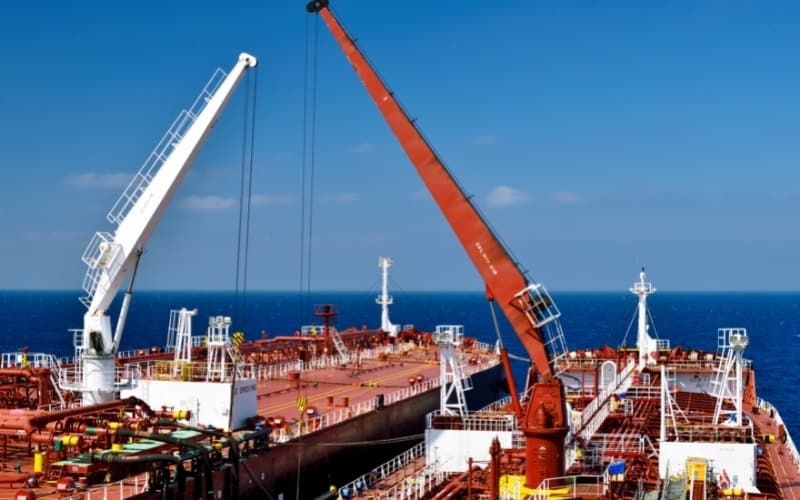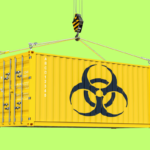What is Ship-to-Ship Transfer (STS) and Requirements to Carry Out the Same?
Ships like oil tankers and gas carriers carry huge amount of cargo in bulk which does not have to be unloaded in just one port but at different ports. Even some carriers like VLCC and ULCC which are massive in size does not berth in port or jetty for discharge operation due to draught restrictions. In such condition ship to ship transfer is utilised.
A ship to ship transfer becomes very economical as ship does not have to berth at the jetty, especially for huge oil tankers, which removes the port berthing charges and also cut short the time for berthing and mooring. But all these comes at a cost of high environmental pollution and fire risk as chances of leakage in operation is always there in open sea when ship is not moored or it is moving.
What is STS or ship to ship transfer?
A STS or ship to ship transfer refers to the transfer of ship’s cargo, which can be oil or gas cargo, between two merchant tanker vessels positioned alongside each other.
Either the ships can be stand still or the STS operation can also be performed while ships are underway. But it requires proper coordination, equipments and approval to perform such operation. Both the masters of the ships are responsible for the entire STS operation
Following are the requirements for conducting Ship to Ship transfer operation:
- Adequate training of oil tanker’s staff carrying out the operation.
- Proper STS equipment to be present on both the vessels and they should be in good condition.
- Pre planning of the operation with notifying the amount and type of cargo involved.
- Proper attention to the difference in freeboard and listing of both the vessel while transferring oil.
- Taking permission from the relevant port state authority.
- Properties of Cargo involved to be known with available MSDS and UN number.
- A proper communication and communication channel to be set up between the ships.
- Dangers associated with the cargo like VOC emission, chemical reaction etc to be briefed to the entire crew involved in transfer.
- Fire fighting and oil spill equipment to be present and crew to be well trained to use them in emergency.
- All guidelines to be followed as per MEPC 59, MARPOL Annex 1 chapter 8, SOPEP, SMPEP, STS transfer guide and operational plan.
Regulations
As Per Resolution of MEPC (59) a new chapter 8 is added to MARPOL Annex I for prevention of pollution during STS operation between two ships.
This new regulation is applicable for oil tankers of 150 GT but bunkering operation and oil transfer operations for fixed or floating platform has been excluded.
Following are the important features:
- The STS operation plan should be approved by administration.
- The STS operation plan is to be in the working language and to be approved not later than the date of first annual survey (intermediate or renewal under MARPOL annex I) carried out on or after 1st Jan 2011.
- The guidelines of the STS plan should be in accordance with the requirements of IMO “Manual on oil pollution prevention, amended section 1” , ICS and OCIMF “ ship to ship transfer guide”.
- The plan may be incorporated in SMS required by the Chapter IX of SOLAS 74, but in any case plan is to be approved as required by the resolution.
- After an approval of administration on STS plan, Operation before 1st April 2012 shall be in accordance to the plan as far as possible.
- The complete operation is to be recorded in Oil Record Book (ORB) and STS operation record book.
- The above record to be retained in the ship for 3 years.
- Any oil tanker under STS plan operate under the territorial waters or exclusive economic zone of MARPOL, must notify the following information to relevant coastal authority prior to 48 hours of the commencement of the STS operation:
– Ship’s name, call sign and IMO number.
– Details of Owner, operator or shipping company.
– Type and quantity of oil for STS operation.
– Preparation done in brief for carrying out the operation.
– Estimated time duration of the complete operation.
– The operation to be performed underway or in anchorage.
– Identification of STS operations service provider or person in charge for overall advisory
- If there is a delay in the ETA, same must be informed to the coastal authority.
- After Delay in ETA, all the information listed above to be re-confirm to coastal authority prior to 6 hrs carrying out the operation
References: simsl
Do you have info to share with us ? Suggest a correction

About Author
An ardent sailor and a techie, Anish Wankhede has voyaged on a number of ships as a marine engineer officer. He loves multitasking, networking, and troubleshooting. He is the one behind the unique creativity and aesthetics at Marine Insight.
Latest Maritime law Articles You Would Like:
Latest News
- What are Logistics Risks?
- How Port and Terminal Operators Can Control Emissions?
- Minimum Quantity Commitment (MQC) and Liquidated Damages in Container Shipping: Concept and Relevance
- MARPOL (The International Convention for Prevention of Marine Pollution For Ships): The Ultimate Guide
- The Ultimate Shipping Container Dimensions Guide
- A Comprehensive Overview of IMDG Code for Shipping Dangerous Goods
Subscribe To Our Newsletters
By subscribing, you agree to our Privacy Policy and may receive occasional deal communications; you can unsubscribe anytime.

















hey…!!
Thank you very much for the article,was very useful….!!
U guyz are doing a great job…!!!
good job!
thks!
I need to know costing for Ship to Ship cost for D2 , 50,000mt in singapore waters
Hi, How about the condition of speed, course, heading and signal of STS operation ? I am working in a project to detect STS operation so I’d like to know which criteria to detect. thanks
Brilliant job
@Ahmed: Thank you so much.
I am a pilot in an oil filed area and engaging for platy of Running STS operation . would you pleas let me know about the running STS certificate and special course.
pleas answer on my Emile
many thanks
@Capt. Ghanbari : Please use our forums to get expert opinions from maritime professionals in your stream- https://forums.marineinsight.com
I will like to have more information on this operation.